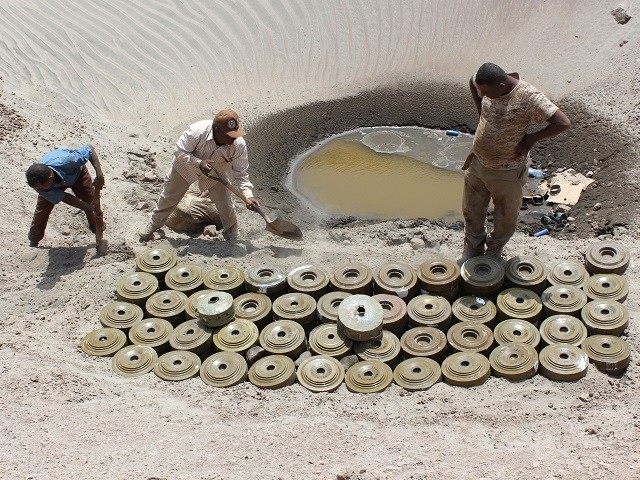The Russian military has allegedly removed over 1,500 mines planted in Palmyra, Syria during the Islamic State’s (ISIS) reign over the ancient city, believed to be intended to detonate simultaneously and level much of the UNESCO World Heritage Site’s priceless ruins.
The Russian Foreign Ministry announced that it had removed 1,500 mines from the city on Wednesday, in conjunction with Syrian military forces under control of dictator Bashar al-Assad. Prior to this announcement, the Russian and Syrian militaries had announced that it had found hundreds of mines and expected the number to be in the thousands. A Syrian officer told Reuters on Saturday that their inspection of the Palmyra site uncovered that “all the government buildings are rigged in a network connected to the Daesh leadership headquarters… The idea was that as we enter it would all go off at once, not just bomb by bomb. And there are a really huge number of bombs.”
Reuters cites Syrian military sources as saying another 3,000 bombs had been detonated since the liberation of Palmyra. Russian and Syrian forces defeated the Islamic State in Palmyra in late March, in a battle where an estimated 400 ISIS jihadis were killed.
“The liberation of the historic city of Palmyra today is an important achievement and another indication of the success of the strategy pursued by the Syrian army and its allies in the war against terrorism,” Assad said of the victory at the time, which has been deemed the biggest ISIS military rout since the terrorist organization lost control of Ramadi, Iraq. The Islamic State’s largest conquests remain its “capital,” Raqqa, Syria, and Mosul, Iraq.
In addition to bombs and traps, Syrian forces uncovered a mass grave of Islamic State victims in Palmyra. 45 bodies and counting have been identified, at least three of which were children.
The combined success of the Russian/Syrian mission in Palmyra with successful moves on the part of U.S.-backed militias and the Kurdish People’s Protection Units (YPG/YPJ) have led some to speculate on whether Russian and American forces will finally work in tandem to defeat the Islamic State. While President Vladimir Putin is a staunch supporter of Assad, who has been accused of numerous human rights violations that led to the beginning of the Syrian Civil War, the White House has insisted that Assad cannot be part of a post-war government.
Nonetheless, Henry Meyer at Bloomberg suggests tensions between Russia and America may be cooling as the Kurds approach Raqqa, while Russian forces take Palmyra on Raqqa’s other side. “Kurdish-led forces backed by the U.S. are also getting closer to ISIS’s capital of Raqqa, raising the possibility of a pincer movement that would bring the U.S. and Russia into a de facto alliance,” he writes. He notes the Pentagon issued a favorable statement regarding the Palmyra operation: “[The Russians] said initially that their primary goal was to go after ISIL in Syria, and they’re doing so now,” Pentagon spokesman Peter Cook said.
Cook is referencing Russia’s initial airstrikes in Syria, which were nominally against the Islamic State but were in practice instead targeting anti-Assad rebels. In November, the United States asserted that their research found only nine in ten Russian airstrikes were in ISIS-held areas. “Moscow has cynically tried to claim that its strikes are focused on terrorist, but so far 85 to 90 percent of Syrian strikes have hit the moderate Syrian opposition and they have killed civilians in the process,” assistant secretary of State for Near Eastern Affairs Anne Patterson said at the time.
The State Department has previously denied any plans to work with Russia to liberate Raqqa. “At least that I’m aware of, no plans militarily to divvy up the labor in the same with those geographical parameters as suggested by [Russian] Foreign Minister [Sergey] Lavrov,” State Department spokesman John Kirby said in March. “I’ve seen no indication that it will [take place].” Kirby was responding to Lavrov’s asserting that Russia was ready to work with the American military on its own terms.
“We are ready to coordinate our actions with the Americans, because Raqqa is in the eastern part of Syria, and the American coalition is mainly… acting there,” he suggested.
Some reports indicate that Russia may be trying to chip away at the American coalition as it publicly calls for cooperation. An Arab source told Breitbart News in March that there is evidence of Russian outreach to militia members of the American coalition. “Russian representatives maintain ties to opposition circles that were until recently backed by the United States, Saudi Arabia, and Jordan,” the source said. In addition to Sunni militias courted by Russia, the Kurdish Peshmerga have admitted to cooperation with Russia, having accepted weapons aid in January.

COMMENTS
Please let us know if you're having issues with commenting.